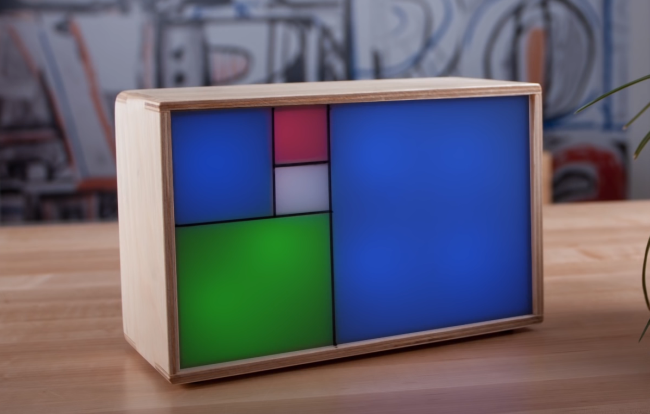Fibonacci Clock: clock and puzzle

Fibonacci watches, as advertised on Kickstarter: “First of its kind. Hacable. Eccentric. Elegant. Running the Arduino. Available as a DIY assembly kit or fully assembled. ”
Well, if we speak in human language, then the essence of the clock is as follows. To find out the time, you need to solve a small puzzle. It is based on the Fibonacci sequence, which is known to fans of mathematics and fans of the series Lost .
How does the clock work?
The Italian mathematician Fibonacci in the 13th century described a sequence of numbers in which each successive number is equal to the sum of the two previous ones. The first two numbers are equal to two units.
')
1, 1, 2, 3, 5, 8, 13, 21, 34 ...
This sequence has many remarkable properties, but this is not about it.
For hours, the first five numbers are enough.
The clock screen consists of five squares with side lengths corresponding to the five first numbers in the Fibonacci sequence: 1, 1, 2, 3, 5. Minutes correspond to the green color, and the clock - red. If a square is used for both digits, then it becomes blue. White squares can be ignored.
To determine the time you have to count a little. To find out the number of hours, add the value of the red and blue squares. For the number of minutes you need to do the same with green and blue. Minutes are displayed in five-minute intervals, so the result must also be multiplied by 5.
In principle, everything is quite simple.

Often there are even several ways to show the same time. For the sake of interest, these combinations are chosen randomly. For example, there are 16 ways to show a time of 6:30, and you never know which watch to choose! So you have to break your head: is it time to get up for work or is it too late?
As a bonus, the clock still works like a lamp.

The author promises to lay out all the charts and instructions necessary for the assembly of watches in the public domain. The clock works on the Atmega328 microcontroller under the Arduino. That is, you can change the program through the Arduino IDE. The author specifically provided for an external FTDI connector, so as not to disassemble the housing to connect the cable.

By the way, the clock on the Kickstarter has long exceeded the modest fundraising goal. The campaign has already collected 125 thousand CAD, and there are still 22 days ahead.
 The inventor of the watch and the author of the project is Philippe Chrétien from Montreal, in the photo on the left (yes, Canadians, they are). Software developer, amateur electronics, programming, mathematics and astronomy.
The inventor of the watch and the author of the project is Philippe Chrétien from Montreal, in the photo on the left (yes, Canadians, they are). Software developer, amateur electronics, programming, mathematics and astronomy.The start of watch sales is promised in November 2015. It must be admitted that there is a good half a year between the collection of funds and the delivery of goods. However, this is often found on Kickstarter.
The author, by the way, also appeals to everyone to help with advice on how to simplify and cheapen the electronic part of the gadget. There will be no problems with the wooden case, it is quite easy to cut out.
Source: https://habr.com/ru/post/367055/
All Articles